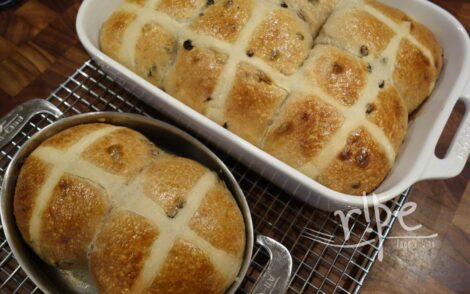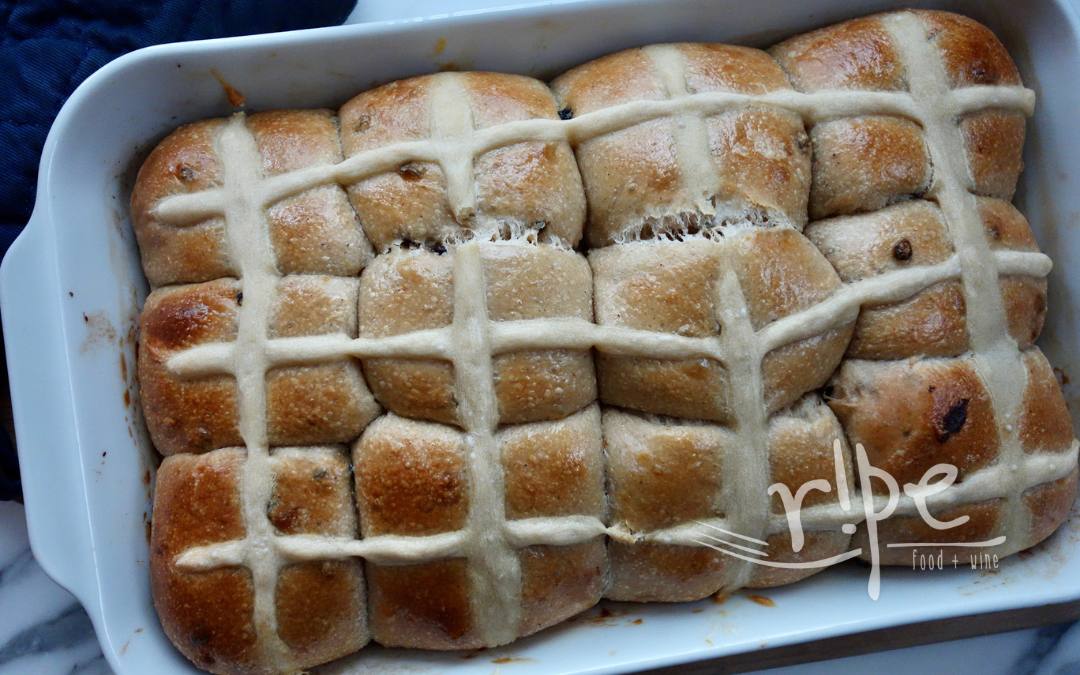I’ve been researching hot cross buns the past week and have been humbled and learned a lot about sourdough baking. When you’re dealing with an enriched dough in our climate (Bozeman, MT, e.g. cold in March) you want to keep the total time spent in bulk fermentation and final proofing to a max of around 8 hours. If you are following a good recipe, your dough should be active and jiggly at 3–4 hours bulk fermentation and after forming, the rolls should rise and be puffy to the touch with 3–4 hours proofing. Of course all this depends on your kitchen and if you have a sort-of warm place to let the magic happen. As some of you know, I set my bowl of dough on my radiator (which isn’t hot to the touch but somehow supplies enough heat to keep our house and any dough I’m working with warm and happy.)

Make 8–12 buns depending on the pans you want to use. Nine fit nicely in a square pan, 10 or a dozen in a larger rectangle. Here I experimented with a smaller rectangle and a bonus mini for the twins.
Sourdough Hot Cross Buns
makes 8–12 rolls depending on size you want; adapted from Maurizio Leo, The Perfect Loaf
Ingredients
Overnight Levain, yields 167 grams
- 64 grams white flour with protein content 12.5–14% Wheat Montana AP (blue bag) has 13% protein and is what I use
- 64 grams water
- 26 grams 100% hydration starter, ripe (e.g. last fed around 12 hours ago)
- 13 grams granulated sugar
Add-ins:
- ½ –¾ cup dried currants or raisins
Mix
- 51 grams unsalted butter, cut into pieces, room temperature about 4 tablespoons
- 450 grams white flour with protein content 12.5–14% Wheat Montana AP (blue bag)
- 167 grams levain (this should be weight of your levain after developing overnight, if not and it is close, use it all and proceed with recipe. If way off on the low end, add equal parts additional flour and water to build to 167 grams.)
- 154 grams whole milk warmed to 76°
- 105 grams water
- 42 grams granulated sugar, divided
- 1 egg 51 grams
- 10 grams Kosher salt 2½ teaspoons
- 1½ teaspoons ground cinnamon
- ½ teaspoon ground allspice or use pumpkin pie spice
- ½ teaspoon freshly grated nutmeg or use pumpkin pie spice
- 1 lemon, zested
- 1 orange, zested
Additional tablespoon of butter for the pan
Egg wash: 1 egg mixed with 1 tablespoon of cream or milk
Cross: 3 tablespoons white flour and about equal amount water and a pinch of salt to make a paste
Instructions
Overnight Levain
-
Mix starter, flour, and water in a pint sized container. Cover loosely and let sit at room temperature overnight.
Mix
-
Cut the butter into ½-inch pats and set on a plate to come to room temperature.
-
Combine the flour, levain, milk, water, half of the sugar (21 grams), egg, and salt in the bowl of a stand mixer with the dough hook attachment. Once combined, mix on medium speed with the dough hook for 5 minutes then let dough rest, covered, for 10 minutes.
-
Add remaining sugar (21 grams), spices, citrus zest, and mix on low for 2 minutes. Turn the mixer up to medium speed and mix for 6 minutes to develop the dough—it should pass a "windowpane test" and if not, mix a couple minutes more.
-
With mixer running on medium speed, add the butter, one pat at a time, mixing until incorporated before adding the next pat. Once all the butter has been added, mix on medium speed for 2 minutes. The dough should be smooth, elastic, and shiny.
Bulk Fermentation (3–4 hours at warm room temperature)
-
Drain the currants and/or raisins and pat dry with a paper towel.
-
Begin bulk fermentation with 3 sets of stretch-and-folds at 30-minute-intervals, either in the bowl or by removing the dough from the bowl and doing it on the counter. At the first stretch-and-fold (at 30 minutes), add the drained and dried currants (or other add-in) by sprinkling a quarter of the amount on top of the dough at each stretch and fold until all is combined. As the fermentation continues, the ingredients will incorporate well into the dough.
How to do a set of stretch and folds in the bowl: Wet your hands and starting at the "noon" position of your bowl, scoop the dough from the bottom of the bowl up and fold it over towards the middle of the dough ball. Repeat this every quarter turn around the bowl—from "noon" to "3 o'clock" bottom stretch to middle, "6 o'clock", "9 o'clock"—one complete trip around the clock equals one set of stretch and folds.
-
Let dough rest for the remainder of bulk fermentation. By the end of the time, the dough should be risen, jiggly, and "alive" feeling. If not, leave for 15 more minutes and check again. As Maurizio says, "The dough should be lofty at this point; don't rush it."
Form (8 to 12 buns) and Proof (3–4 hours at warm room temperature)
-
Butter interior of baking pan, an 8-by-8-inch square or larger rectangle work well.
-
Scoop dough from bowl onto counter. Divide into equal pieces, anywhere from 8 to 12 rolls depending on your desired bun size and baking dish you want to use.
-
Using a bench scraper, round each piece into a taught ball, stretching the dough from the top, down the sides, and tucking it underneath itself. Work around the dough ball a few times to get it nice and tight. Transfer to buttered pan. When all buns are in the pan, cover loosely with a piece of oiled-plastic wrap and set in a warm place to proof.
Preheat Oven and Add the Crosses
-
Preheat oven to 400° F. Prepare egg wash and brush over the tops of the buns.
-
Mix the cross paste with flour, water, and a pinch of salt in a small bowl until smooth. You want the cross paste to be thick enough to pipe and hold its shape somewhat; start with equal parts of flour and water, adding more water to thin out the paste. Transfer the paste to a piping bag with a small tip or use a plastic sandwich bag and nip off a small piece at one corner. Pipe across the pan in three stripes then rotate 90° and pipe across three more stripes.
-
Bake for 15 minutes at 400° then lower heat to 350°, rotate pan 180°, and continue to bake until finished, 10–15 more minutes until buns are golden brown with internal temperature 195°. Transfer pan to wire rack to cool completely. Optionally brush tops of buns with melted jam or honey (see note.)
Recipe Notes / Tips
- If you don't have whole milk, use what you have. We keep 2%, half-and-half, and cream around, so I do a mixture that is about 3/4 2% and top it off with half and half or cream.
- Variation: These buns are fantastic made with chocolate chips, either all chocolate or mixed with dried, sweetened cranberries.
- Variation: If you like candied lemon or orange peel, these buns are a great place to use it. Add to or replace some of the currants.
- I prefer my hot cross buns unglazed because I like to split and toast them and a sticky top makes that messier. If you'd like a glaze, brush it on when the buns come out of the oven.
- Optional glaze: Melt a couple tablespoons of jam (apricot or orange marmalade work well) or honey over low heat and brush atop buns when they come out of the oven.



